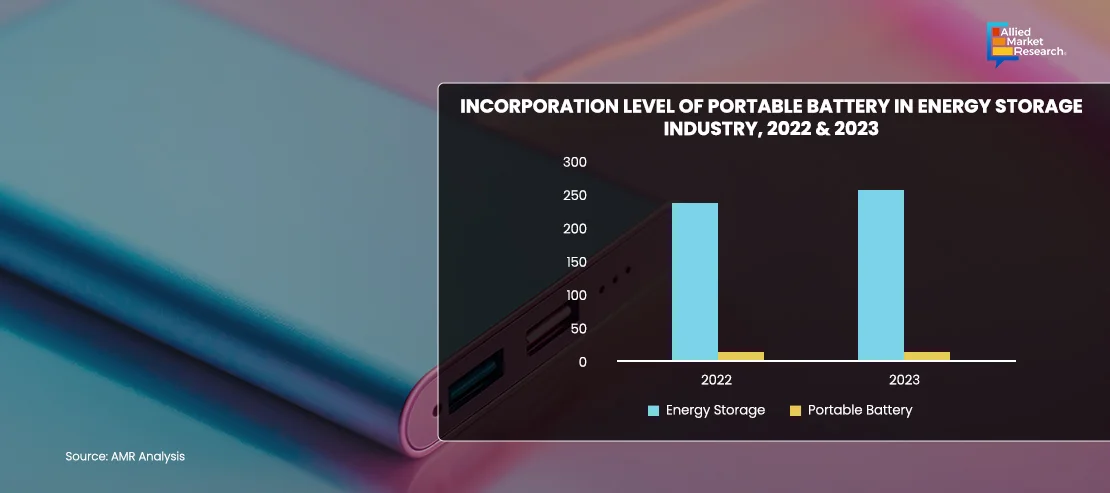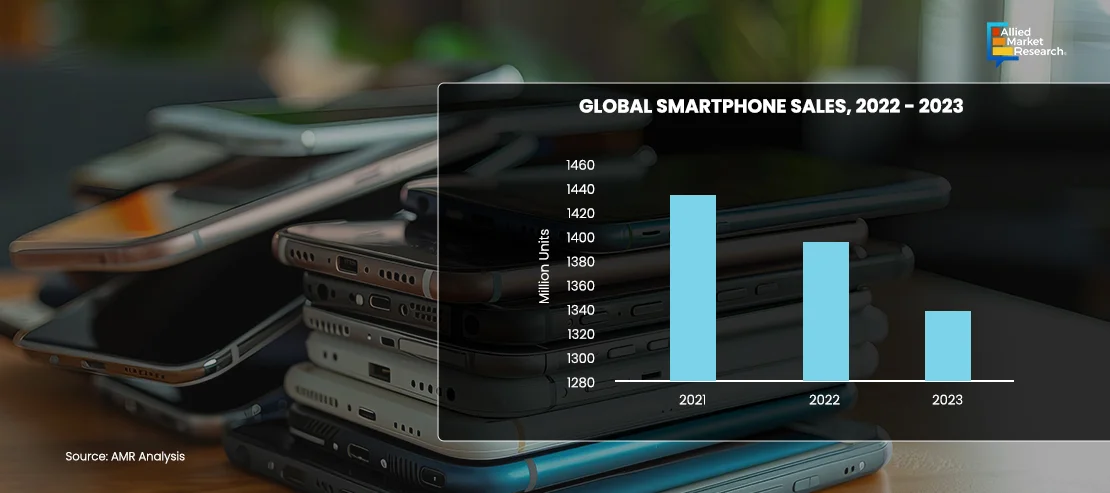Table Of Contents

Yerukola Eswara Prasad

Koyel Ghosh
Portable Batteries: Future in the Making

A portable battery is a type of electrical battery that can be hand-carried. Portable batteries mostly find their applications in the electronic, telecommunication, and automotive sectors. Due to the depletion of petroleum-based energy sources, the development of battery storage systems like portable batteries has increased significantly. According to a study by AMR, the global portable batteries market is anticipated to register a CAGR of 10.4% from 2021 to 2030.
Batteries store energy for use when needed, which is important for devices that require power but aren't constantly connected to an electrical grid. They are also used in energy storage systems for renewable energy sources like solar and wind power for providing energy. Portable batteries, often referred to as power banks or portable chargers, offer several advantages. These batteries can charge devices even without the presence of any connected power source. They provide extra power to your devices, such as smartphones, tablets, or laptops, extending their usage time. In case of unexpected power outages or emergencies, portable batteries can serve as a backup power source, ensuring that all essential devices like phones, flashlights, or medical equipment are in usable condition. Modern portable batteries are designed to be energy-efficient, minimizing power loss during charging and ensuring that most of the stored energy is transferred. By providing a reusable power source, portable batteries reduce the need for disposable batteries, which can be harmful to the environment. Additionally, they support the use of renewable energy by storing power generated from solar and other sources.
Increase in concerns among the population regarding the environment has led to a rise in adoption of electric vehicles, which, in turn, has led to surge in demand for portable batteries. In addition, rapid advancements in consumer electronics in modern society coupled with rise in awareness regarding their advantages is one of the key driving factors of these batteries. Also, the increase in global warming and depletion of petroleum resources have led to the development of electric power-driven, heavy-duty industrial vehicles, which are expected to foster the demand for them. The surge in demand for high computing and portable gadgets such as smartphones and laptops are one of the key factors contributing to the growth of the portable battery market.
Increasing Incorporation of Portable Battery Technology
Battery energy storage systems are becoming an integral part of grid modernization. These systems help grid operators save electricity when the electricity generated exceeds the demand. The growing demand for battery energy storage is expected to increase due to grid modernization, a shift towards a low-carbon economy, and the rise of renewable energy. In addition, the surge in the number of major projects of rural electrification and the decline in lithium-ion battery prices are expected to create significant growth opportunities for the players operating in the market. The adoption of these systems improves the reliability and flexibility of electricity supply systems for the generation, transmission, and distribution of electricity. For instance, an Indian government public sector undertaking (PSU) invested in the commercial scale installation of battery energy storage systems along with Solar PV Projects in July 2022. The government of India also supports some of the storage projects through grant support funds.
Incorporation level of portable battery in energy storage industry, 2022 & 2023

However, in the above figure, it can be seen that portable battery technology is still in its nascent stage. The R&D activities are being conducted on a regular basis, to upgrade this technology and increase its efficiency. For instance, Bluetti launched Swapsolar battery technology. The company says the battery can be charged through solar panels and used in many other devices. The individual battery packs have a capacity of 717-watt hours. Based on this technology, the company also plans to launch other devices which will be compatible with the Swapsolar battery packs. This approach is projected to enable the company to gain a strong foothold in the battery swapping sector, thereby sustaining their competitive advantage.
A lithium-ion battery is a type of rechargeable portable battery. These batteries have high energy density around 250-693 W-h/L and low self-discharge. It has cycle durability of about 400-1,200 cycles with more than 90% discharge efficiency. An increase in innovation and development of technology especially in the field of IoT has fostered the demand for electronic gadgets, which, in turn, fuels the demand for portable batteries. Simultaneously, the rise in need for new medical and consumer products such as hearing aids, digital watches, and other smart technologies has further increased the demand for portable batteries, thereby contributing to its growth.
Advancements in Portable Batteries Revolutionizing Smartphone Technology for a Connected World
The consumer electronics industry has experienced remarkable advancements in the last few years. These innovations are driven by rapid progress in fields such as artificial intelligence, connectivity, and materials science, alongside a growing focus on sustainability and user-centric design. The advent of 5G networks, the rise of smart and connected devices, and the integration of AI into everyday gadgets have redefined the consumer experience, making technology more intuitive, responsive, and personalized. Smartphones and power tools are some of the most prominent examples where portable batteries are being developed to cater to the new needs of the consumers.
As more regions gain access to high-speed internet, particularly in emerging markets, smartphones become essential for accessing information. The rollout of 5G networks is driving demand for new smartphones that are compatible with this faster, more reliable technology, enhancing the user experience with improved download speeds and connectivity. Continuous improvements in smartphone hardware, such as better processors, battery technology, high-resolution displays, and advanced camera systems, drive consumers to upgrade to newer models. Increasing consumer awareness about sustainability is leading to demand for smartphones made from recycled materials and those offering better energy efficiency, compelling manufacturers to innovate in these areas.
Battery improvement is an essential area of innovation in the smartphone market, driven by the need for longer battery life, faster charging, and overall better energy efficiency. Ongoing improvements in lithium-ion and lithium-polymer battery technology have increased energy density, allowing batteries to store more power without increasing in size. This results in longer battery life for smartphones. Advanced battery management systems use AI and machine learning to optimize power usage based on user behavior, extending battery life. These systems also help in balancing charging cycles to prevent battery degradation. Solid-state batteries, which use a solid electrolyte instead of a liquid one, promise to offer higher energy density, faster charging, and improved safety. While still in development, this technology has the potential to revolutionize smartphone battery performance. Researchers are exploring graphene-based batteries for their potential to greatly surpass traditional lithium-ion batteries in charge speed, capacity, and longevity. These factors are driving ongoing improvements in smartphone battery technology, addressing consumer demand for longer battery life, faster charging, and more sustainable energy solutions.

Nonetheless, smartphone sales have been showcasing a declining trend of more than 4% year on year, majorly from 2021 onwards. In many developed regions, smartphone penetration is already very high. As smartphones become more advanced, consumers are holding onto their devices longer, often waiting three to four years before upgrading. This shift has contributed to slower replacement demand. Also, ongoing supply chain disruptions, including semiconductor shortages, have impacted smartphone production and availability, leading to delays and reduced inventory in some markets. In the post-pandemic landscape, consumers have increasingly prioritized spending on experiences, travel, and other interests over upgrading personal technology, which contributed to a challenging environment for smartphone sales in 2023, marking a decline after years of growth. However, this trend could reverse as economic conditions improve, new innovations emerge, and consumer confidence returns.
Portable batteries are particularly useful for travelers and outdoor enthusiasts, enabling extended smartphone use in situations where access to power outlets is limited, thereby making smartphones more versatile and reliable in various environments. With portable batteries, users are more likely to fully utilize features like GPS navigation, high-resolution video recording, and augmented reality applications, which are typically more power-intensive. Portable batteries can help bridge the gap in areas with limited power access, enabling more people to use smartphones for communication, education, and business, thereby driving smartphone adoption. For instance, Chinese mobile manufacturer Honor has developed a new higher-capacity battery technology which uses silicon carbon, resulting in shorter charging time. Also, Samsung is developing a solid-state battery, which is currently in R&D stage, and is expected to be launched by early 2027. Such an approach by these companies is anticipated to help in increasing the demand for portable batteries mainly in the smartphone application sector.
The Crux
The growth of portable battery technology is intricately associated with the evolving needs and behaviors of smartphone users. As smartphones play a bigger role in our lives, the need for reliable power solutions is growing. Portable batteries have become essential, allowing longer use of smartphones and other devices. They help overcome battery limitations and support power-hungry features, driving the growth of consumer electronics.
Allied Market Research provides comprehensive insights into the rapidly expanding sector od portable batteries. Our comprehensive reports delve into the latest technological advancements, market trends, and pertinent government initiatives, providing businesses with the essential insights needed to seamlessly incorporate smart batteries into their operations. Staying updated on these important areas empowers companies to make informed strategic decisions and seize emerging market opportunities. For specialized expertise in energy and power, related to smart batteries, reach out to our team today!

